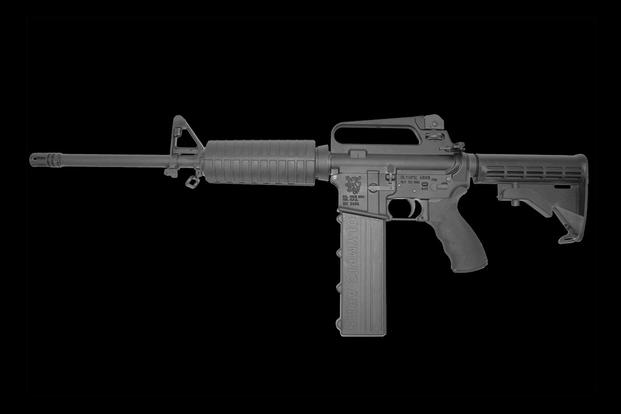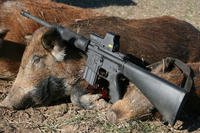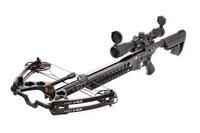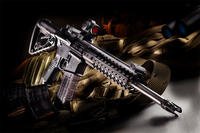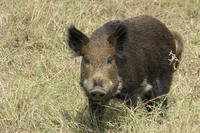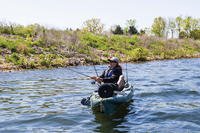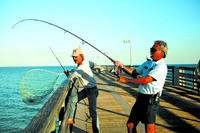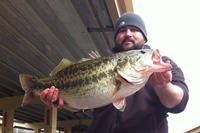A small game rifle has to be very accurate, close enough is not an option. Golf ball size targets allow little room for error, and it’s nice if it’s accurate with more than one brand of ammunition. I like shooting match ammunition as well as the next guy, but it’s hard when part of the grocery budget goes to buying match grade ammo. Finally, a small game rifle needs to function flawlessly and be reliable for a fast follow-up shot.
The idea of hunting small game with an AR has intrigued me for years. However, the potential accuracy of a .22 Long Rifle (LR) bullet from a 1:9 inch twist barrel didn’t seem promising, so I shelved the idea until I found a dedicated upper chambered in .22LR with a proper twist. The dream of using an AR for small game was getting closer.
The M261 Conversion Kit
The original M261 conversion kits were first introduced to the U.S. Army in 1978 for training purposes. According to the operator manual issued with the kit, it was "designed to replace the standard bolt carrier group without any modifications to the rifle" These kits come equipped with 10-shot inserts that fit into standard 20-round issued magazines.
The original conversion body adapter assembly consists of four components: the bolt group; spring; straight pin and the barrel; guiderail and rail support group, which are connected and considered one piece. The barrel is an insert and slips inside the 5.56 chamber, which is chambered for .22LR. These kits don’t use redirected gas to cycle the action, but instead use the simple blowback of the fired cartridge developed by John Browning and used in just about every semi-auto .22 rifle like the Marlin Model 60 or Ruger 10-22. Since accuracy was poor from these early conversions, many manufacturers began looking at ways to improve it.
The Players
Olympic Arms
Olympic Arms offers the AR enthusiast a wide array of options from dedicated guns to conversions in calibers ranging from their new .300 OSSM, (Olympic Super Short Magnum) to standard pistol cartridges like the 9mm, .40 S&W, .45 ACP and our test model — the .22LR.
The Olympic upper matches both the weight and feel of its big brother, the AR-15 carbine rifle. It would be a good training aid for practice, saving on cost of ammo and convenience, as many indoor ranges don’t allow the 5.56/.223., but allow the .22LR upper. This would keep the shooter in tip top shooting form during the offseason or cold-weather months.
The forged Olympic flattop upper was delivered complete with carbine length handguard and standard issue A2 front sight. I thought, at first, a mistake had been made; it looked just like the 5.56/.223 model complete with birdcage flash hider until I turned the unit upside down and noticed the M261 bolt inside the receiver.
Olympic has taken the original idea of the M261 and expanded it, quite literally, the barrel on the Olympic upper is a full length 16-inch barrel liner that fits neatly inside a non-rifled A2 profile barrel. Aside from the extra length insert, the bolt is either an original M261 or an exact copy of one.
The Olympic upper arrived with a 20-round polymer magazine with the manufacturer’s name, Black Dog, molded on one side and Olympic Arms molded on the other. The magazine is molded to standard 30-round AR magazine dimensions.
Compass Lake Engineering
The Compass Lake Engineering (CLE) .22 Long Rifle forged upper arrived looking more like a National Match rifle than a match rifle itself – complete with a full length handguard, a removable carrying handle equipped with ¼ inch National Match rear sight and a 21-inch heavy profile stainless steel Douglas barrel. The barrel measures .740 inches and is finished with an 11-degree target crown.
The bolt adapter assembly on the CLE is nearly identical to the original M261, sans an insert. The barrel face on the CLE is machined to match the bolt including the chamber, extractor slot and clearance for the ejector. The barrel attaches to the receiver in the same way as its larger cousin, with a barrel nut. The barrel is chambered with a match chamber that closely matches the Bentz chamber favored by .22 competition shooters for extreme accuracy.
The CLE came with two standard 10-round magazines that had been converted from standard issue 20-round magazines complete with Hartford bottom plates.
The Testing
Though accuracy was the prime purpose of the testing, I also wanted to test reliability of feeding and ignition, which often plague semi-autos chambered in 22LR. To keep the playing field as level as possible I used the same Bushmaster lower and a set of Warne Magnum Rings, which allowed me to switch the Hawke variable 3-12X scope with the SR6 reticle to both uppers.
Olympic Arms Upper
The Olympic was initially plagued by failure to fire, which I attribute to inexpensive ammunition, as it only failed with cheap ammo. Several times the magazine put the bullet in the top of the receiver which prevented the bolt from closing and required the upper to be broken down to remove the cartridge. After examining the bolt, I felt that the problem could be blamed on the Parkerized finish on the bolt which led to the misfiring, as the bolt was not fully closing due to the finish. As the Parkerizing wore off, reliability improved and misfires became fewer. The Olympic Arms upper had no failure to fire or misfires with high velocity ammunition or the high-end standard velocity ammunition. It doesn’t need match grade, but it does need top shelf.
The Black Dog magazine holds the bolt open when the last cartridge is ejected. I would really like to see Olympic use a shorter magazine, as longer magazines aren’t conducive to shooting from a bench.
The Compass Lake Engineering Upper
The CLE upper fed and ejected flawlessly, with the exception of two occasions when it failed to fire. This could have been an ammunition problem, but the unfired cartridge did not extract when the charging handle was brought to the rear. The extractor simply jumped over the unfired case held tight by the match chamber which engraves the bullet when the bolt slams closed and didn’t allow the unfired cartridge to extract. This is common on .22s with a tight match chamber. Pulling the trigger again did, in fact, fire the cartridge in both cases and the empty ejected as though nothing had happened.
The 10-round magazines supplied by CLE, like the standard issue magazines converted with the 10-shot insert, does not stay open when firing the last shot, but CLE does offer an optional 10-round magazine that will lock open after the last shot.
Accuracy
After testing the uppers for function and reliability the business of accuracy came to the forefront. The question that needed answered was "Are the .22LR uppers accurate enough?"
I determined that match ammunition would more than likely outperform high velocity ammo, but still held out hope that I could get enough accuracy from some of the high velocity fodder to use on small game and varmints like groundhogs without incurring the cost of match grade ammo. Since most .22-game targets are only about 2-inches in diameter, if any of the types of ammo delivered a group larger than 2 inches at 50 yards it was deemed not satisfactory for small game.
I used a range of ammunition from the expensive high-end Eley EPS Match ammunition to the inexpensive Winchester Wildcat, which can be picked up at your local box store in bulk. Predictably, the Eley EPS outperformed all the rest, but as the chart shows, a few standard brands printed good groups from both uppers. Hyper velocity ammunition, with the exception of the ultrafast CCI Stingers, didn’t fare so well. That could be a timing issue, but for the most part, these uppers preferred standard velocity loads.
The Verdict
Both the uppers tested were more than adequate for small game hunting with at least one brand, and performed satisfactorily in each of the test categories, especially after a break-in period of a couple hundred rounds smoothed things up.
The CLE out shot the Olympic, but to compare the two uppers would be like comparing a Chevy Luv to a new Avalanche. The Olympic is a basic conversion whereas the CLE is built from the start as a match gun, so direct comparison is unfair. The cost of each of the uppers reflects their purpose. The CLE sells for twice the price of the Olympic. Is that price justified? That’s up to you. How accurate do you need your .22 rifle to be?
I see the .22 upper as an asset for any AR hunter, if for nothing more than to acclimatize themselves with their rifle and to get in more practice for less money. Of course, slipping through your favorite patch of woods carrying an AR and looking for a squirrel and dumpling dinner is the optimum use of a .22 upper.
50 Yard Accuracy Results: 5-shot groups
| Olympic 22 Long Rifle Upper | |
|---|---|
| Eley EPS | .528 |
| Winchester Power Point HP | .760 |
| Wolf Target Standard Velocity | 1.096 |
| Winchester Wildcat | 1.476 |
| CCI Stinger | .910 |
| Compass Lake Engineering 22 Long Rifle Upper | |
|---|---|
| Eley EPS | .153 |
| Winchester Power Point HP | .241 |
| Wolf Target Standard Velocity | .371 |
| Winchester Wildcat | .729 |
| CCI Stinger | .835 |
